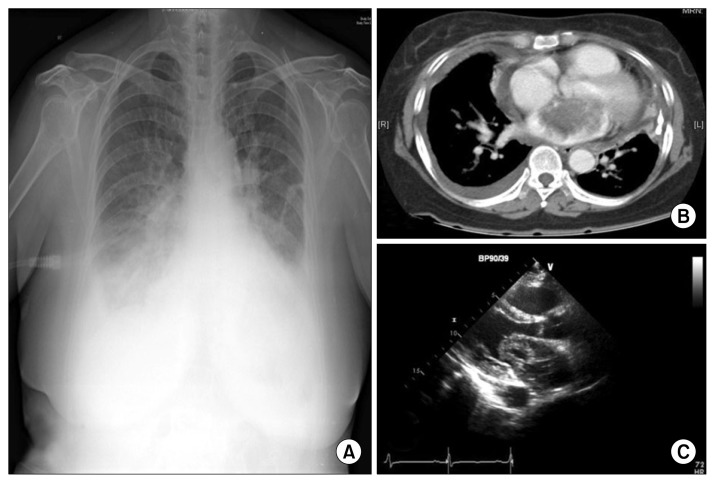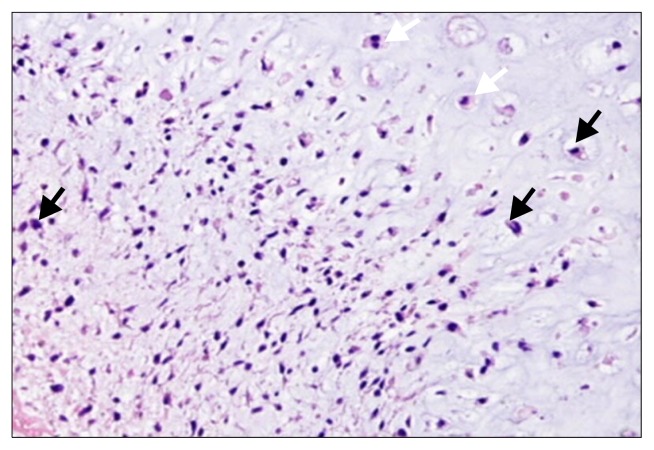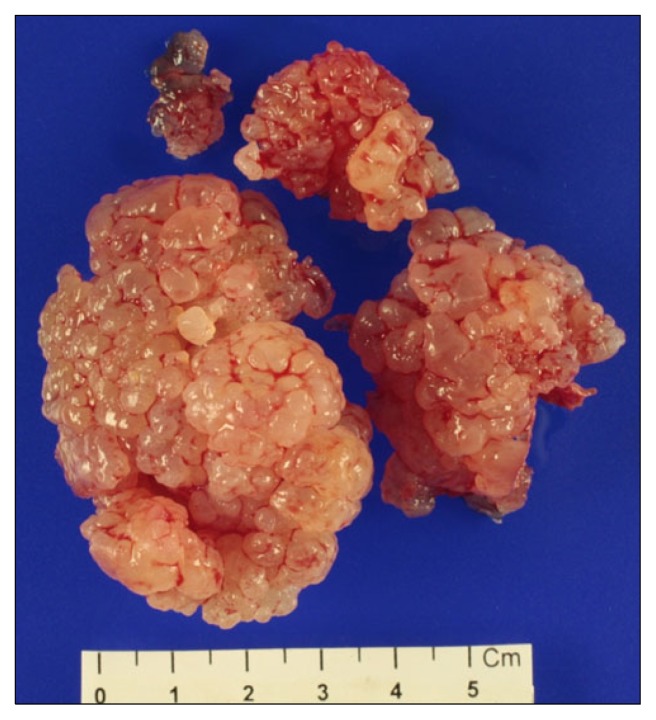Abstract
Chondrosarcoma is a rare entity of malignant tumor which arises from cartilaginous tissue, and the literatures on this disease are scarce. The first-line of treatment for cardiac chondrosarcoma is surgery. Due to early local recurrence and distant metastasis, the prognosis is poor even after complete surgical excision. We present a case of chondrosarcoma in the left atrium causing functional mitral stenosis which required urgent surgical intervention, and the successful treatment outcome.
Keywords: Chondrosarcoma; Heart neoplasms; Neoplasms, Connective tissue
CASE REPORT
A 58-year-old woman with an eight-year history of hypertension was referred to our institution due to progressive dyspnea. Based on clinical symptoms, the New York Heart Association (NYHA) Class of the patient was class IV heart failure despite ten days of intensive medical management. A chest X-ray showed both pulmonary edema and pleural effusion (Fig. 1A). Computed tomography revealed a large lobulated tumor in the left atrium (Fig. 1B). An electrocardiogram finding was normal sinus rhythm with left atrial enlargement. An echocardiogram revealed a heterogeneous, round, echogenic mass attached to the left atrium and severe functional mitral stenosis, with a mitral diastolic pressure gradient of 10 mmHg, due to a mass protrusion into the left ventricle during diastole phase (Fig. 1C). With the echo result and severity of symptoms, emergent surgical treatment was decided.
Fig. 1.
(A) Preoperative chest X-ray. (B) Enhanced axial computed tomographic image. (C) Transthoracic echocardiography image.
During the operation, the left atrium was accessed via bia-trial approach. The mass occupied most of the left atrial cavity and extended into the left ventricle through the mitral valve. The mass measuring 8×6×4 cm in size was well-circumscribed, friable, lobular, chondroid mass shaped like a bunch of grapes with a pinkish-white rugged surface, and it resembled the eggs of frog. The mass was attached to the left atrial septal wall and protruded into the left ventricle via the mitral valve. Therefore, the mitral orifice was almost completely obstructed by this extremely large mass. Since the friable, extremely large tumor was diffusely attached to the left atrial septal wall, it was removed in four pieces along with the atrial septal wall. After the mass was completely excised, the defect of the atrial septal wall (2×3 cm) was closed with patch of Dacron (‘double velour’).
Pathological examination revealed a malignant cartilaginous tumor showing hypercellularity, moderate nuclear atypia, and hyperchromasia. The multifocal area of the tumor revealed frequent binucleate or multinucleate lacunae (Fig. 3). The mass did not demonstrate necrosis or malignant calcification, and its morphology suggested a diagnosis of chondrosarcoma.
Fig. 3.
A histological examination demonstrated sheets of atypical cells with cartilaginous differentiation, including malignant chondrocytes (black arrows) and binucleate or multinucleate lacunae (white arrows) (H&E, ×100).
The patient was extubated 27 hours after the operation. Her postoperative course was unremarkable, and she was discharged 17 days after surgery. At the six-month follow-up, she did not have a residual tumor in the left heart or mitral valve dysfunction, the atrial septal wall defect was successfully repaired, and her cardiac function was classified as New York Heart Association class I.
DISCUSSION
Extra-skeletal chondrosarcomas are rare neoplasms, representing approximately 2% of all soft tissue sarcomas. Only about ten reported cases in the English literature, primary cardiac chondrosarcoma in left heart is extremely rare [1–3].
Chondrosarcoma is a malignant tumor of cartilaginous tissues that rarely originates in the heart. Primary chondrosarcoma in the left heart often originates from the myocardial tissue and mostly found in left atrium. It is presumed to arise from multipotent mesenchymal stem cells which undergo malignant cartilaginous differentiation [3,4]. The tumor frequently originates from the endocardium, grows into the atrial or ventricular cavity, infiltration progress through the myocardial wall, extends into the pericardium and mediastinal structures [1–4]. Systemic metastases are observed in 80% of patients during their initial diagnosis. The lungs and mediastinal lymph nodes are especially susceptible to metastatic deposits [1]. It is suggested that metastatic lesion is often found in right heart or lung [2,4]. In our case, imaging modalities, including a skeletal survey and gastrointestinal endoscopy did not reveal distant metastasis.
The clinical presentation of cardiac chondrosarcomas includes intracavitary obstruction, cardiac tamponade, peripheral embolism, congestive heart failure, and various related symptoms. Transthoracic echocardiography remains the diagnostic tool of the choice for the initial evaluation of cardiac masses which can clearly depicts the heart morphology in a variety of imaging planes. Computed tomography reveal accurate imaging of the heart and the surrounding mediastinum, and provides better soft-tissue contrast than echocardiography [1–3]. It also can show calcification and hemorrhagic areas within tumors. However, computed tomography is still far inferior to echocardiography in the depiction of small moving structures such as the cardiac valves. Magnetic resonance imaging is adequate for demonstrating the extension of tumors to the interatrial septum and pulmonary veins, as well as beyond the myocardium into the pericardial space with disruption of the pericardium. In most cases, however, histologic confirmation is the definitive diagnosis of primary cardiac malignancy [2–4]. In this case, the preliminary diagnosis was myxoma rather than chondrosarcoma, until we obtained the histopathological report after surgery, despite a pre-operative evaluation involving echocardiography and computed tomography.
The prognosis of cardiac chondrosarcoma is poor, where survival is generally measured in weeks or months [3,4]. In most patients with this condition, the results of treatment have been dismal. Surgery remains the first line of treatment for cardiac chondrosarcoma, although long-term survival rates after excision are low because of early local recurrence and metastases. Complete resection can be difficult due to infiltration of the myocardial wall [1,3,4]. Surgery is recommended for pathologic confirm but also to relieve the compression caused by the tumor, because partial or complete relief of symptoms may significantly improve the duration of survival and quality of life [1,2,4,5]. Chemotherapy and radiotherapy are indicated for malignant cardiac lesions that are not suitable for radical surgery; however, these therapies have not been demonstrated to result in clinical benefits [2–5]. In our case, six months after radical excision, the patient was healthy without local recurrence or metastases.
In conclusion, primary chondrosarcoma of the heart is an extremely rare malignancy, which can only be definitively diagnosed after a pathological examination. Radical surgery most likely offers the best hope for palliation and prolonged survival.
Fig. 2.
Gross findings of cardiac chondrosarcoma. The tumor was a relatively well-circumscribed, friable, lobular, chondroid mass shaped like a bunch of grapes with a pinkish-white rugged surface. It resembled frog eggs and measured 8×6×4 cm.
Footnotes
CONFLICT OF INTEREST
No potential conflict of interest relevant to this article was reported.
REFERENCES
- 1.Ng SH, Ko SF, Yang TS, Wong HF, Wan YL, Ho YS. Primary cardiac chondrosarcoma. Am J Emerg Med. 1996;4:285–7. doi: 10.1016/S0735-6757(96)90178-3. [DOI] [PubMed] [Google Scholar]
- 2.Izzo P, Ricci N, Capolupo R, et al. A rare case of primary chondrosarcoma of the heart. J Cardiovasc Med (Hagerstown) 2007;8:210–3. doi: 10.2459/01.JCM.0000260842.68532.04. [DOI] [PubMed] [Google Scholar]
- 3.Zhang G, Chen X, Guo L, Feng Q, Ni Y. Primary cardiac chondrosarcoma. J Card Surg. 2012;27:186–8. doi: 10.1111/j.1540-8191.2011.01406.x. [DOI] [PubMed] [Google Scholar]
- 4.Parmar C, Jojo A, Vachhani KC, Vijayan SN. Primary chondrosarcoma of the heart. Eur J Cardiothorac Surg. 2008;33:513–5. doi: 10.1016/j.ejcts.2007.11.029. [DOI] [PubMed] [Google Scholar]
- 5.Miwa S, Konishi Y, Matsumoto M, Minakata K. Primary cardiac chondrosarcoma: a case report. Jpn Circ J. 1997;1:795–7. doi: 10.1253/jcj.61.795. [DOI] [PubMed] [Google Scholar]





